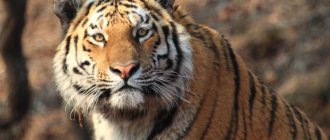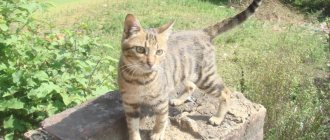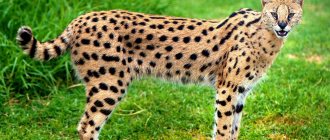- Wild animals
- >>
- Mammals
The wild manul belongs to the kingdom - Animals, phylum - Chordata, class - Mammals, order - Carnivores, family - Felines, subfamily - Small cats, genus - Cats.
Weighing between 2.2 and 4.5 kg, this mammal is recognized by its small body, short legs, thick fur and bushy tail. The body length of the Pallas's cat varies from 50 to 65 centimeters, and the length of the tail varies from 20 to 30 centimeters.
Origin of the species and description of the Pallas's cat
Photo: Manul cat
Early cats could well have been similar to such a modern Madagascar predator as the fossa. These mammals occupy the same niche in the wild as all felines.
About 18 million years ago, modern cats (Felidae) emerged from Schizailurus. The first modern representatives of felines were the early cheetahs (Miracinonyx, Acinonyx). They are believed to have appeared about 7 million years ago. Some sources report that the North American cheetah (Miracinonyx) evolved from Acinonyx only 4 million years ago, but recent research by scientists suggests that Miracinonyx was likely the ancestor of both cheetahs and pumas (Puma).
About 12 million years ago, the genus Felis first appeared, from which many of today's small cats finally evolved. The two first modern Felis species were Martelli's cat (Felis lunensis †) and Manul (Felis manul). The extinct Felis species are Felis attica, Felis bituminosa, Felis daggetti, Felis issiodorensis (Issoire lynx), Felis lunensis and Felis vorohuensis. Thus, Pallas cats are the most ancient cats today.
The genera Acinonyx, Felis and Panthera are represented by individuals living today. The classification of some of these modern species is regularly updated and rearranged as more ancestral fossils become available. They provide reliable clues as to who descended from whom, and at what time many species diverged.
Clouded leopard
The clouded leopard is one of the ancient species of cats.
The beautiful spotted-marbled coat of the clouded leopard, which lives in the tropical forests of southeast Asia, is still a valuable prey for poachers. Deforestation also played an important role in reducing the species' population. As of 2008, the clouded leopard population numbered 10,000 adults and is considered endangered. A subspecies of the clouded leopard, the Taiwan leopard, was already declared extinct in 2013.
Appearance and body structure features
Photo: Wild cat Pallas
The small manul cat (Felis manul) has a squat body with thick, soft fur. The coat color varies from light gray to yellowish brown. The white tips of its fur give the Pallas's cat a "snowy appearance". Subtle stripes are visible on the sides of the body; the head of the Pallas's cat is round with black spots on the forehead.
The large eyes are greenish-yellow in color and the pupils constrict into a round shape, unlike most small cats whose pupils constrict into a vertical line when exposed to light. The mammal's ears are short, rounded, and located quite low on the sides of the head. Pallas's legs are short and strong, the tail is thick and drooping. It is colored with five or six thin rings and has a black tip.
Pallas' cats look fatter than they actually are due to their dense fur. They are well adapted to their Central Asian habitat, which is dominated by steppes, cold deserts and rocky terrain. Pallas' cat specimens have been found at altitudes ranging from 4,000 to 4,800 meters.
Thick fur protects the body from the cold, and the bushy tail is often used for warmth. The unique shape of the eyes and the position of the eyelid protect well from cold winds and dust. The Pallas' cat is a good climber who easily climbs rocks and jumps over crevices. The flat head and low-set ears are an evolutionary adaptation for pursuing prey in open areas with little vegetation.
Bornean clouded leopard
The Bornean leopard is active mainly at night.
Despite its similar name to the previous leopard, the Bornean or Kalimantan leopard is not a subspecies of it. The Bornean leopard lives in the rain and mangrove forests of Borneo and Sumatra. There is no reliable data on its abundance, but the species is classified as vulnerable due to degradation and transformation of wooded areas, which are the habitat for this species, into rubber plantations.
Where does the manul cat live?
Photo: Steppe manul cat
The wild manul cat is found in Central Asia, in the Caspian Sea, Iran, Afghanistan, Pakistan and northern India. The wild cat also lives in central China, Mongolia and southern Russia. The population in the southwestern part of their range - in the Caspian Sea region, Afghanistan and Pakistan - is declining significantly. Pallas's cat is almost impossible to find on the Tibetan Plateau. Mongolia and Russia currently make up the majority of their range.
The habitat of the Pallas's cat is characterized by an extreme continental climate with little rainfall, low humidity and a wide range of temperatures. They have been found at altitudes up to 4800 m in cold, arid habitats among steppes and rocky deserts.
These small predators prefer valleys and rocky areas where they can hide, as they avoid completely open habitats. Pallas' cats also do not like areas with heavy snow cover (above 10 cm). 15-20 cm is the limit for this species.
The habitat seems huge for such a small cat. For example, in Mongolia, the average distance between females is 7.4-125 km2 (average 23 km2), while the range between males is 21-207 km2 (average 98 km2). From this we can assume that for every 100 km2 there are from four to eight individuals.
Amur tiger
Despite conservation measures, the population of the Amur tiger is recovering very slowly.
It is also Siberian, it is Far Eastern, it is also Ussuri. This noble, incredible beast is the largest representative of the cat family and the only one of the tiger species who can survive in the harsh conditions of the Ussuri forests. The population of the ruler of the taiga declined rapidly from the end of the 19th century to the 30s of the last century, until it reached 20-30 individuals! The extermination of the species was facilitated not only by targeted poaching for the beautiful striped skin and other parts of the tiger carcass for further sale to Asian countries, but also by a reduction in the number of ungulates in the tiger’s habitat and active deforestation of taiga areas. As of 2015, according to the tiger census, 520-540 Siberian tigers live in the Russian Far East. The animal is listed in the Red Book and has the status of an “endangered species,” but there is still hope for the Amur tiger.
What does the wild cat eat?
Photo: Wild animal manul
The prey of Pallas's cat is very diverse. Wild cat hunts:
- voles;
- marmots;
- protein;
- various birds (including larks, aviaries and partridges);
- insects;
- reptiles;
- scavengers.
The steppe manul cat hides during the day in small abandoned caves that previously belonged to marmots or foxes. Since Pallas' cats are extremely slow, they must position themselves low to the ground and get close to their prey before leaping. To avoid becoming prey for eagles, wolves, red foxes or dogs, they move in short steps and then hide while eating.
The highest activity in searching for food for the Pallas's cat is at dusk and dawn. Wild cats can also hunt during the day. Other predators, such as corsac foxes, red foxes and European badgers, rely on the same food sources as Pallas's cats. To avoid competitive exclusion, there is a principle that states that species that rely on the same resources cannot coexist in the same habitat. Based on this, Pallas' cats have adapted seasonal food-seeking behavior.
In winter, when there is not enough food, Pallas cats actively search for hibernating or frozen insects. Winter is the time for badgers to hibernate, so wild cats successfully avoid competition for prey.
Black-footed cat
The black-footed cat is the smallest representative of wild cats in Africa.
A resident of South Africa, the black-footed cat (other names - small spotted cat, informal ant tiger) is one of the smallest wild cats. The weight of an adult male is from 1.5 to 2.4 kg. Black-footed cats often occupy abandoned burrows of other animals or settle in termite mounds. Although the cat is not of interest to hunters, it is nevertheless considered a threatened species, since it often dies from poisons and traps set for jackals, and besides, the places chosen by it are actively developed by people and converted into pastures for livestock. The black-footed cat interbreeds with domestic cats, which also contributes to the degradation of the species.
Features of character and lifestyle
Photo: Pallas' cat
The character of the Pallas' cat is complex. The animal is extremely secretive and cautious. Like other representatives of other cat cats, manulas are loners. Of all the cats that exist in the wild, the Pallas' cat is the slowest and most incapable of moving quickly. Manul, like other predators, loves the night time. Despite the fact that this mammal can hunt during daylight hours, Pallas’ cat prefers to sleep during the day. Due to individual characteristics, such as slowness and deliberation, the Pallas's cat often has to guard its prey near the hole. The color of a wild cat's fur acts as camouflage.
The Pallas' cat hides from enemies in gorges, on rocks or in holes. This cat makes its cozy den from old badger or fox holes, or adapts itself in rock crevices and small caves. This is what helps the Pallas cat to go unnoticed if he hides. Manul is the slowest among wild cats. When irritated or aggressive, Pallas' cat emit loud sounds that have many similarities with the sounds of an owl.
Kalimantan cat
A Kalimantan cat living in the Pulong Tau Nature Reserve.
Malaysia A little-studied species of wild cats lives on the island of Borneo (Kalimantan). There is no reliable data on the way of life, as well as the number of Kalimantan cats, since the animal behaves extremely carefully and the likelihood of meeting it in nature is extremely low, especially considering the active deforestation of the Kalimantan forests. A live specimen can fetch $10,000. The estimated population ranges from 50 to 2,500 mature individuals.
Social structure and reproduction
Photo: Pallas cat kittens
It is believed that the male Pallas's cat roams an area of about 4 km2, but there is no reliable scientific evidence for this. Scientists report that the mating call of the Pallas's cat sounds like a mixture of the barking of young dogs and the cry of an owl.
Pallas' cats have an annual breeding season. Females of this species are polygamous, meaning that a male can mate with multiple females. The breeding season lasts from December to early March, and the gestation period averages 75 days. From 2 to 6 kittens are born at a time. The cubs are born at the end of March and remain with their mother for the first two months.
After the kittens are born, the male does not take part in raising them. Once the kittens leave the nursery, they will learn to forage and hunt at the age of 4-5 months. At about 1 year of age, they become mature and can find their mates. The average lifespan of the Pallas's cat is approximately 27 months, or just over 2 years, due to the extreme environmental conditions and high susceptibility to becoming prey. In captivity, Pallas' cat lives up to twelve years.
Cheetah
Female cheetah with cubs
The fastest predator of the cat family is the cheetah. Distributed throughout Africa, as well as in the Middle East. The cheetah is significantly different from all other big cats, since, like canines, it is able to pursue prey over fairly long distances (cats, as a rule, do not run after prey, they prefer to kill it by pouncing from cover in one powerful, deadly leap), and also has non-retractable claws.
As of 2007, there are only 4,500 adult cheetahs in Africa, and the Asiatic cheetah subspecies found in Iran numbers no more than 60 individuals. Factors such as a decrease in the number of ungulates and persecution by humans have led to the vulnerability of the species. Cheetahs reproduce very poorly in captivity due to the peculiarities of social behavior; moreover, all existing cheetahs are close relatives of each other, and inbreeding always leads to genetic degeneration of the species. Perhaps due to inbreeding, more than half of all cheetah cubs do not survive one year.
Reasons for the decline in the number of Pallas cats
Photo: Wild cat Pallas
The main threats to the Pallas' cat population are:
- other predators;
- Human.
Pallas' cats exist in nature in small numbers and are poorly adapted to protect themselves from predators. Their dependence on specific habitats makes them extremely vulnerable. The fur of this wild cat is valued in many markets. In the early 1900s, up to 50,000 cats a year were killed for their skins.
Habitat degradation is intensifying and has an impact on the existence of the Pallas's cat. Domestic dogs and human factors account for 56% of Pallas' cat deaths in central Mongolia alone. Cats are sometimes mistakenly killed by hunters, mistaking them for marmots.
Mongolia's population is threatened by overhunting and poaching. Pallas' cats are hunted for domestic purposes, and it is also possible to obtain permission from local authorities. However, law enforcement is weak and there are no control measures. Perhaps the most serious threat to this little cat is government-sanctioned poisoning campaigns to control the species' population, which are carried out on a large scale in Russia and China.
Snow Leopard
The snow leopard blends perfectly with the surrounding nature, but this will not save it when it meets a person.
Neither does the snow leopard or the snow leopard. The “ghost” predator lives mainly in the mountainous regions of Central Asia. The secretive lifestyle, as well as the inaccessibility of the snow leopard's habitats, makes it difficult to estimate the population, but experts believe that the number of this species is continuously declining. The main reason for the extinction of the snow leopard is the illegal hunting of the animal for its magnificent skin. A big problem is the undeveloped defensive behavior of the snow leopard, which, when meeting a person, prefers to timidly freeze against the backdrop of mountain slopes instead of fleeing from an armed poacher like the plague. The lack of enemies of the snow leopard among other predators played such a cruel joke. As you understand, such encounters usually end in death for the animal.
The number of snow leopards, according to WWF, is about 4,000 individuals; only 70-90 snow leopards live in Russia.
Far Eastern leopard
The Amur leopard reproduces extremely poorly in captivity.
The rarest subspecies of leopard is on the verge of extinction and is included in almost all protection documents. In the Primorsky Territory National Park “Land of the Leopard” there are only 87 individuals (as of 2017), about 12 more adult animals are in China. Huge damage to the Far Eastern or Amur leopard was caused by poachers. The illegal shooting of animals was caused by the widespread demand for skins and other parts of carcasses, which are used in oriental medicine, as well as unemployment and poverty of the population of the Primorsky Territory. The species is threatened by a reduction in the number of ungulates, habitat degradation and inbreeding, which causes genetic depletion of the species (due to a small population).
Nutrition
Pallas' cats are real predators. They feed on fresh game, which they hunt down themselves. The menu consists of mice, small rodents and birds. It happens that you come across a gopher, and it’s even better if you manage to catch a hare. But such luck does not always occur.
If an unsuccessful hunt occurs in the summer, then the steppe cat is not too upset; he can also dine on insects. True, then you have to eat more of them, but it is also easier to catch them. Sometimes Pallas' cat eats grass, but this is not at all because they are trying to get enough; most likely, this is how he cleanses his stomach, which becomes clogged with wool.
Sumatran tiger
The Sumatran tiger is very ferocious and can attack people.
It is endemic to the island of Sumatra, located in the western part of the Malay Archipelago. The Sumatran tiger is the smallest representative of the tiger species, but the most aggressive. The species is small in number and is endangered due to illegal hunting and habitat destruction. The cost of a Sumatran tiger carcass on the black market is $20,000. Sumatran tiger attacks on humans are not uncommon: at least 8 people have been killed by them since 2002. Listed in the International Red Book and the CITES Convention.
Source
Chilean cat
Kodkod is an excellent climber and excellent tree climber.
Another predatory baby comes from South America. Its other name is kodkod. The weight of an adult cat is a maximum of 2.7 kg. The species is included in the International Red Book as vulnerable; the population of the species is about 10,000 adult animals. The species is threatened by both poachers and habitat loss (deforestation).
Diet
Vision and hearing are the basis of the Steppe cat's hunting system.
The animal waits for prey in ambush and then catches it, making several jumps that can be up to three meters in length. It kills small prey by digging its claws into it and biting the neck or back of the head with its fangs. When attacking large game, the cat jumps on the back of the animal and tries to sever the neck or carotid artery. The beast will not continue to attack if the potential prey manages to escape.
The African Spotted Cat preys primarily on mouse-like murids, and to a lesser extent on birds, small reptiles and invertebrates.
Steppe cats, regardless of their natural habitat, do not refuse to destroy bird nests or eat insects and turtles.
Chinese cat
In Chinese, the Gobi cat's name is "huang mo mao", which means "yellow-furred cat."
Also called the Gobi cat, it is a Chinese endemic and is found primarily in the mountainous and steppe regions of northwestern China. Outwardly it resembles a jungle cat. The Chinese cat is a rare species and belongs to the vulnerable species. According to approximate data, the number of Chinese cats is less than 10,000 mature individuals. The Chinese cat is pursued by humans because its skin is of interest to artisans. There is evidence that the campaign to exterminate rodents, which are the main food for this feline, carried out in the late 50s played a big role in reducing the number of Gobi cats.
Iriomotean cat
The Iriomote Island cat is a subspecies of the Bengal cat.
An extremely rare species that is endemic to the subtropical Iriomote Island, part of Okinawa Prefecture, Japan. This cat originally had a limited range and an extremely modest population. At the moment, the number of Iriomotey cat is no more than 100 adult individuals.
Some locals consider its meat a delicacy, which greatly harms the species. Crossbreeding with wild cats of other species also contributes to the decline of the Iriomotean cat. The species is on the verge of extinction, therefore it is protected and listed in the International Red Book.










